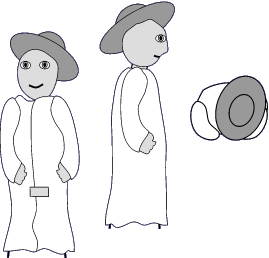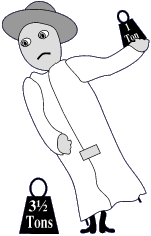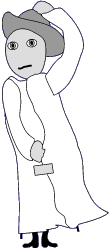 Begin by sketching your design ideas, and then transfer them to graph paper. You need at least two drawings, front and side, a top view is often useful too.
Begin by sketching your design ideas, and then transfer them to graph paper. You need at least two drawings, front and side, a top view is often useful too.

When designing a giant there is a tendency to concentrate on the visual aspects to the detriment of the poor porter who has to carry it. Any giant must be balanced for carrying. If he can't be carried, he's a statue!
 Begin by sketching your design ideas, and then transfer them to graph paper. You need at least two drawings, front and side, a top view is often useful too.
Begin by sketching your design ideas, and then transfer them to graph paper. You need at least two drawings, front and side, a top view is often useful too.
 The idea is to make the giant balance for weight, wind, and inertia. If you think back your school physics lessons you may recall 'moments'. Giant designers use simple moment calculations to balance their creations. Don't worry, the maths is rarely very complicated, by using graph paper we can reduce it to pairs of simple multiplications.
The idea is to make the giant balance for weight, wind, and inertia. If you think back your school physics lessons you may recall 'moments'. Giant designers use simple moment calculations to balance their creations. Don't worry, the maths is rarely very complicated, by using graph paper we can reduce it to pairs of simple multiplications.
 Draw a vertical line through the centre of your giant, it must also pass through the centre of the porter. Any force acting on one side of the line must be balanced by an equal force acting on the other side. That's why it's easier to carry one heavy bag of shopping in each hand than both in one hand. If you do have to carry a heavy weight in one hand you may find yourself waving the other in the air to assist your balance.
Draw a vertical line through the centre of your giant, it must also pass through the centre of the porter. Any force acting on one side of the line must be balanced by an equal force acting on the other side. That's why it's easier to carry one heavy bag of shopping in each hand than both in one hand. If you do have to carry a heavy weight in one hand you may find yourself waving the other in the air to assist your balance.
 To balance a force on one side you need an equal force on the other side. This does not mean the the objects exerting the forces have to be identical. A force can be balanced by another, half the size, exerted twice as far from the centre-line.
To balance a force on one side you need an equal force on the other side. This does not mean the the objects exerting the forces have to be identical. A force can be balanced by another, half the size, exerted twice as far from the centre-line.
 So: If something is exerting a force, say an off centre weight, multiply the magnitude by the distance from the centre. The balancing force ( or forces ) must, when multiplied up in the same way, come to the same figure. If a force is too large, either reduce it's size, or move it nearer the centre-line.
So: If something is exerting a force, say an off centre weight, multiply the magnitude by the distance from the centre. The balancing force ( or forces ) must, when multiplied up in the same way, come to the same figure. If a force is too large, either reduce it's size, or move it nearer the centre-line.
For example: A giantess holds a lamp weighing 3kg at a distance of 0.3m from the centre in her right hand, and a book in her left hand at a distance of 1.2m from the centre, how much should it weigh to maintain balance? 3 x 0.3 = 0.9 divide the result by 1.2 and obtain the result, in this case 0.75 (750g) --- Why? because 1.2 x 0.75 = 0.9 and it's the forces that must balance, not the weight of the individual items.
 Another example: A giant holds a shield with an area of 2.5 square metres the middle of which is 0.5 metres to the left of centre, In his right hand is a broadsword with an area of 0.4 square metres. In order that the giant is not spun around by a gust of wind the sword must be held 3.12 metres away from his body: 2.5 x 0.5 = 0.4 x 3.12 Even for a giant 3.12 metres is a bit of a stretch, so it might be better to move the shield towards the centre of the body - any bit that crosses to the other side effectively cancels out part of the rest.
Another example: A giant holds a shield with an area of 2.5 square metres the middle of which is 0.5 metres to the left of centre, In his right hand is a broadsword with an area of 0.4 square metres. In order that the giant is not spun around by a gust of wind the sword must be held 3.12 metres away from his body: 2.5 x 0.5 = 0.4 x 3.12 Even for a giant 3.12 metres is a bit of a stretch, so it might be better to move the shield towards the centre of the body - any bit that crosses to the other side effectively cancels out part of the rest.
 Don't forget that these balances must work from front to back as well as from side to side. It's a good idea to look at the forces on a plan view. If a line between them passes right over the centre of the giant, and they are balanced, then you'll be OK. If the line passes off centre then the result is liable to fall over.
Don't forget that these balances must work from front to back as well as from side to side. It's a good idea to look at the forces on a plan view. If a line between them passes right over the centre of the giant, and they are balanced, then you'll be OK. If the line passes off centre then the result is liable to fall over.
Curved surfaces are double trouble. Quite apart from the simple effect of catching the wind, they are liable to act as an aerofoil at certain angles.
Inertial problems are only apparent when the giant changes his speed or direction. They are a factor of dynamic balance.
When the giant is standing still, or moving smoothly along a straight, level route, the porter will be concerned only with the weight, and any wind acting on the giant. If the porter has to stop in a hurry he must control the tendency of the giant to keep going, or topple over.
If the centre of gravity of the giant is too far above the porter's head he may be unable to stop the giant until he has covered several metres slowing all the while. He may find it hard to turn sharply; needing to take corners wide, or else to stop, turn on the spot, and re-start. Dancing may be impossible.
 Inertial problems are exaggerated by anything that is allowed to swing independently. Small, light objects on short lines will have very little effect, but heavy accessories on long links may present nightmare difficulties.
Inertial problems are exaggerated by anything that is allowed to swing independently. Small, light objects on short lines will have very little effect, but heavy accessories on long links may present nightmare difficulties.
 As the giant changes motion the hanging object will lag behind and drag that side of the giant back, the porter will strain to bring the giant level. The swinging object will then catch up and overtake the rest of the giant causing that side to jerk forwards, the porter holds back, and the cycle repeats. Turning can be even more difficult as the swinging object opposes the motion at every stage. It is theoretically possible for two swinging objects to be used to cancel each other out, in practice this is likely to be fiendishly difficult to arrange.
As the giant changes motion the hanging object will lag behind and drag that side of the giant back, the porter will strain to bring the giant level. The swinging object will then catch up and overtake the rest of the giant causing that side to jerk forwards, the porter holds back, and the cycle repeats. Turning can be even more difficult as the swinging object opposes the motion at every stage. It is theoretically possible for two swinging objects to be used to cancel each other out, in practice this is likely to be fiendishly difficult to arrange.
If the centre of gravity of the giant is kept as low as possible, inertial forces are easier to control. In desperate situations extra weight may be added at the base of the frame; the added burden is worth the improved control that results. Any force that acts below the level at which the porter carries helps him maintain balance. Any force which acts above the porter hinders his balance.
Objects rigidly attached to the giant's frame may be assumed to generate forces that act at their actual position. Objects loosely attached, which may include free swinging clothing, generate forces that will act at the point of attachment. Low slung accessories will cause the porter to work as if they were held much higher up.
Be kind to your porter, plan for balance.
This page is an extract from the BIGG member's handbook.